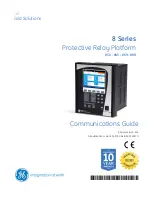
phenomenon that is well known to protection engineers. During the time when any of the
current transformer connected to the differential IED is saturated, the sum of all CT secondary
currents will not be equal to zero and the IED will measure false differential current. This
phenomenon is especially predominant for busbar differential protection applications, since it
has the strong tendency to cause unwanted operation of the differential IED.
Remanence in the magnetic core of a current transformer is an additional factor, which can
influence the secondary CT current. It can improve or reduce the capability of the current
transformer to properly transfer the primary current to the secondary side. However, the CT
remanence is a random parameter and it is not possible in practice to precisely predict it.
Another, and maybe less known, transient phenomenon appears in the CT secondary circuit at
the instant when a high primary current is interrupted. It is particularly dominant if the HV
circuit breaker chops the primary current before its natural zero crossing. This phenomenon is
manifested as an exponentially decaying DC current component in the CT secondary circuit.
This secondary DC current has no corresponding primary current in the power system. The
phenomenon can be simply explained as a discharge of the magnetic energy stored in the
magnetic core of the current transformer during the high primary current condition.
Depending on the type and design of the current transformer this discharging current can
have a time constant in the order of a hundred milliseconds.
Consequently, all these phenomena have to be considered during the design stage of a busbar
differential IED in order to prevent the unwanted operation of the IED during external fault
conditions.
The analog generation of the busbar differential IEDs (RADHA, RADSS, REB 103) generally
solves all these problems caused by the CT non-linear characteristics by using the galvanic
connection between the secondary circuits of all CTs connected to the protected zone. These
IEDs are designed in such a way that the current distribution through the IED differential
branch during all transient conditions caused by non-linearity of the CTs will not cause the
unwanted operation of the differential IED. In order to obtain the required secondary CT
current distribution, the resistive burden in the individual CT secondary circuits must be kept
below the pre-calculated value in order to guaranty the stability of the IED.
In new numerical protection IEDs, all CT and VT inputs are galvanically separated from each
other. All analog input quantities are sampled with a constant sampling rate and these
discreet values are then transferred to corresponding numerical values (that is, AD
conversion). After these conversions, only the numbers are used in the protection algorithms.
Therefore, for the modern numerical differential IEDs the secondary CT circuit resistance
might not be a decisive factor any more.
The important factor for the numerical differential IED is the time available to the IED to make
the measurements before the CT saturation, which will enable the IED to take the necessary
corrective actions. This practically means that the IED has to be able to make the
measurement and the decision during the short period of time, within each power system
cycle, when the CTs are not saturated. From the practical experience, obtained from heavy
current testing, this time, even under extremely heavy CT saturation, is for practical CTs
around two milliseconds. Because of this, it was decided to take this time as the design
criterion in REB 670 IED, for the minimum acceptable time before saturation of a practical
magnetic core CT. Thus, the CT requirements for REB 670 IED are kept to an absolute
minimum. Refer to section
"Rated equivalent secondary e.m.f. requirements"
However, if the necessary preventive action has to be taken for every single CT input
connected to the differential IED, the IED algorithm would be quite complex. Thus, it was
decided to re-use the ABB excellent experience from the analog percentage restrained
differential protection IED (that is, RADSS and REB 103), and use only the following three
quantities as the inputs into the differential algorithm in the numerical IED design:
1.
incoming current (that is, sum of all currents which are entering the protection zone)
2.
outgoing current (that is, sum of all currents which are leaving the protection zone)
3.
differential current (that is, sum of all currents connected to the protection zone)
Section 6
1MRK 505 370-UEN D
Differential protection
94
Busbar protection REB670
Application manual
Summary of Contents for REB670 Series
Page 1: ...Relion 670 SERIES Busbar protection REB670 Version 2 2 IEC Application manual ...
Page 2: ......
Page 22: ...16 ...
Page 64: ...58 ...
Page 226: ...220 ...
Page 244: ...238 ...
Page 358: ...352 ...
Page 392: ...386 ...
Page 398: ...392 ...
Page 436: ...430 ...
Page 454: ...448 ...
Page 466: ...460 ...
Page 474: ...468 ...
Page 475: ...469 ...
















































